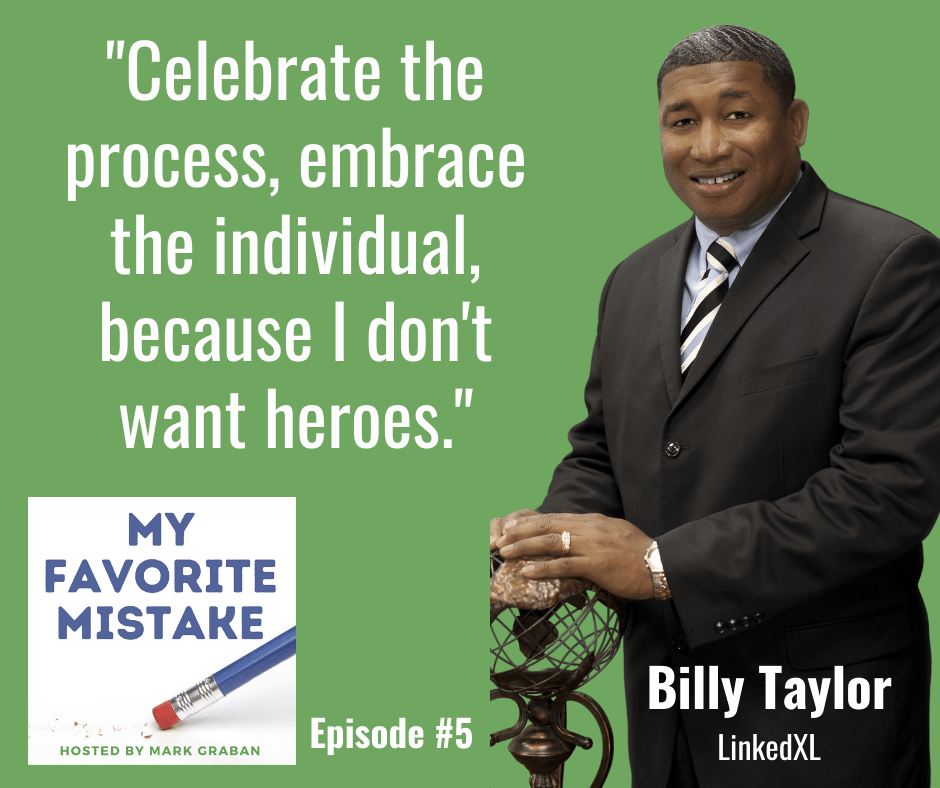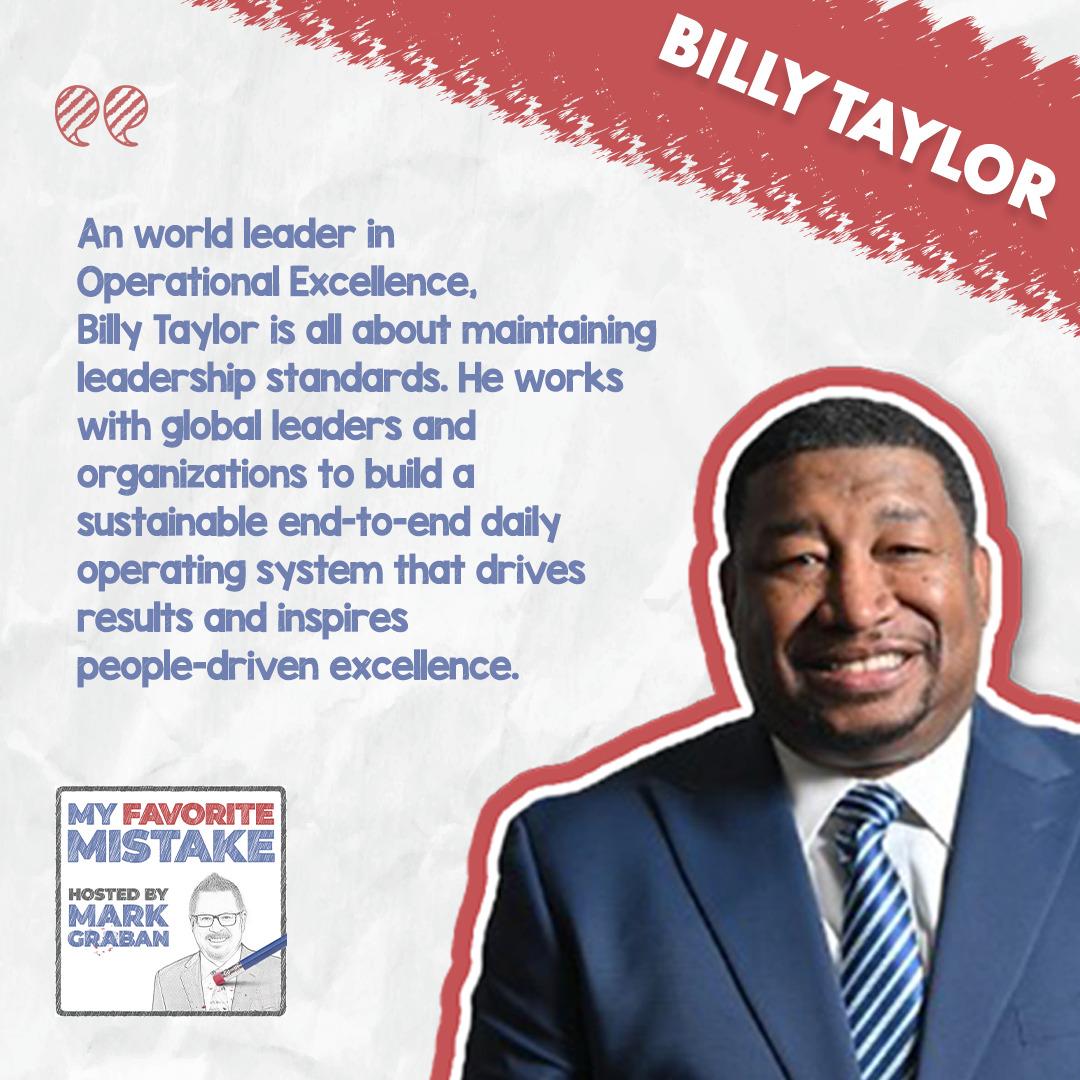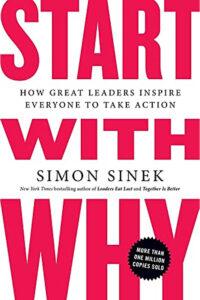Listen:
Check out all episodes on the My Favorite Mistake main page.

My guest for Episode #5 is Billy Ray Taylor, a retired Goodyear executive and now the founder and CEO of his firm, LinkedXL.
In today's episode, Billy talks about his “favorite mistake” in which he was “compromising on the standard” early in his career as a leader. “What were the standards for leadership?” he asks. How did mentors and his leaders help him learn the importance of maintaining standards? He then transitioned from being the student to being the teacher.
“What you accept, you cannot change. What you tolerate, you can never change.”
Billy Taylor
Short Clip:
Watch the Full Episode:
Quotes:



Subscribe, Follow, Support, Rate, and Review!
Please follow, rate, and review via Apple Podcasts or Podchaser or your favorite app — that helps others find this content and you'll be sure to get future episodes as they are released weekly. You can also become a financial supporter of the show through Anchor.fm.
You can now sign up to get new episodes via email, to make sure you don't miss an episode.
This podcast is part of the Lean Communicators network.

Other Ways to Subscribe or Follow — Apps & Email
Executive Billy Taylor On Not Adhering To The Standard In Operations Leadership

Our guest is Billy Taylor. He is a retired Goodyear Executive where his roles included being a Plant Director, Executive Director of Commercial Manufacturing North America, and Global Head of Diversity and Inclusion. He's now the CEO of his company, LinkedXL. Billy, I'm glad you're here to share your lessons and experiences with us. How are you?
Very good, Mark. Thanks for having me. I'm excited to share my favorite mistake because it was also my favorite lesson.
That's what it's all about, turning mistakes into lessons learned.
Absolutely. Thank you for having me.
We'll jump right in. What do you consider to be your favorite mistake?
My favorite mistake was compromising on the standard. What's the guideline? What's the standard for operation? Early in my career, I received my first leadership role on a large scale. I was leading approximately 600 people in a business center. At that point, I was this young leader, around 27 years old. I moved into this role, but I was leading people that I grew up with in the plant.
At that point, you want to be liked, fit in, and have the team gel. I started compromising on what the standards were for operating and what were the standards for leadership. For example, when I walk the plant, sometimes I see people not wearing their personal protective equipment. To walk by that is compromising the standards.
People are coming late to meetings and people coming unprepared to meetings and not performing tasks. For me, where the lesson came was my boss and my mentor would take me on a morning walk every morning. It was a leadership walk. When things were out of place, he would look at me, and he would point those out and say, “That's not the standard.” He would always say, “What you accept, you cannot change. What you tolerate, you can never change.”
What you cannot accept, you cannot change. What you tolerate, you can never change. Share on XIt wasn't registering with me at that point. He could see it wasn't registering with me. As a young leader, I would give people passes. There were different standards for different players. There are different standards for the A players and the D players. I'm trying to go along to get along as the leader. I'm going through this regiment. The paperwork hadn't been official yet to me moving to the business center role. I was someone in the interim role.
This leader calls me into a meeting, and he has this envelope in his hand. I'm thinking that I'm about to get this 15 to 30% raise, and I'm excited. He has an envelope. He writes me up for poor performance. I was furious because we had performed at a level that that business center hadn't seen in 3 or 4 years. However, we weren't meeting the standard. The letter says, “You failed to meet the standard. For that, there are severe consequences.” He handed me this letter and I'm upset.
I said, “You asked me to deliver zero customer losses to my customer over a 30-day period.” He says to me, “Is that difficult or is it impossible?” I said, “It's difficult, darn near impossible.” He says, without a smile, “What you're telling me is it's achievable.” He hands me the letter and I walk out of his office. He had also become a friend of mine as well as my mentor. He called me when I got back to my office and I wouldn't answer the phone. I was so mad at him. I thought he was so unfair. I thought he wasn't treating me right. He says to me, “You don't own it. When you don't own it, you want to blame. You're blaming me for giving you a letter because you accept nonconformance to the standard.” That changed my life.
That letter or a surprise was a wake-up call.
Your standards shape your culture, and culture control strategy. It’s ironic. Over time, I shifted. What I realized was I started holding people accountable for the standard. The lesson learned was, what you accept, you can't change. It should be enforced all the time and every time with everyone consistently. What I realized was when I started to progress through my career, when I went into new organizations, the way that you shape culture is to adhere to your standard.

Don't compromise on your standard. You're compromising on yourself, even your personal existence. When you compromise who you are and what you represent, you personally diminish yourself. You undervalue yourself. Later on, what was interesting was I had a chance to transition from being the student to being the teacher.
I'm in a role and I'm leading North America. I had a plant manager whom I'd went to his facility on numerous occasions to coach and help develop. I had two questions I would ask leaders that are allowing nonconformance. The first question is, “What do you need from me?” The second question is, “Why do you accept that?” Why do I say that? I have to be a part of the solution first. When I went to this plant, it was probably the third visit. I realized this plant manager is not holding his team accountable to the standards. We're failing to improve. I show up with my backpack and a picture of my family and my backpack. I said, “How are you doing, sir?” He says, “Great.”
I said, “Do you know why I'm here this visit?” He says, “Yes, you're here to help.” I said, “No. That was the last two visits.” I said, “See this picture? This is a picture for me to make a decision. I have to make a decision. Who's going to eat? You or them? You or my family? I'm going to leave this on your desk throughout my whole visit as a constant reminder of why it's important to hold people accountable to the standard because it's a way of life.” I said, “May I take a picture of your family with me to my hotel room? Apparently, I love them more than you do.” This leader totally transitioned from an accountability perspective. Even now, he is now changing cultures. The standard is the standard. When you start to build in standard work, processes, and procedures, you have to adhere to them. If you don't, failure's imminent.
I want to go back to that moment when you had that awakening and your boss gave you that wake-up call. How did you translate that into action? You talked about not holding people accountable for wearing their safety glasses. How did you start taking steps toward holding people to standard? How did you learn then to coach others to that? Starting with yourself, what actions did you take after that meeting?
I went back and took a page from Simon Sinek’s book, Start with Why. Why are the standards important? Why are we doing the standards? I brought my team together collectively and recalibrated. It wasn't something I was doing that was punitive. It was bringing them together for alignment. The best leaders do three things very well. When you're building standards, define winning. Once you define winning, align winning.

Once you have alignment, then you can truly execute winning. When I went back, the lesson learned was I very clear on my expectations of what the standards were. I let everyone know what your role was in alignment. Here's what you own. In the absence of ownership comes blame. At that point, the next time, I was very fair about what the expectations were or what the standards were with extreme clarity, and then I started holding people accountable.
When we talk about creating a climate where people learn from mistakes, what are some things that you did as an executive at Goodyear to help try to create that environment? You probably know the old Toyota-ism of no problem is a problem. How do we make it safe for people to bring up problems to admit mistakes in the name of learning and progress?
Create a cultural, psychological safety where it's safe to bring things to my attention. I don't expect perfection because perfection doesn't exist. What I do expect is transparency. I wanted to create an environment where they could come to me with real issues instead of hiding them. Ali Molloy says in this book, “You can't manage a secret. If people are hiding things, then you can't manage them. You can't fix them. You can't correct them. The only way they're going to bring those things up is if you create an environment where it's safe to bring those things up.” It's not punitive. When people bring things to me as a leader, I celebrate them. I accept them saying, “We like mistakes. I love the fact that you brought those mistakes and those errors to me.” That's the only way we can mistake proof by knowing what the issue is.
Celebrate the red. Create a cultural, psychological safety where it’s safe to bring things to my attention. I don’t expect perfection because perfection doesn’t exist. What I do expect is transparency. Share on XPractically speaking, what does that mean to mistake-proof work or error-proof work? That's a really important concept.
Mistake proofing is going in and it's almost a PDCA plan to check at. You go in and you identify what the issue is. In some cases, for those Lean geeks out there, it's like Six Sigma. Some of you've heard of that continuous improvement, the DMAIC. We go through that, Define, Measure, Analyze, Improve, and Control. For me, it's one, a common language when I start to mistake-proof. I go in and identify what the issue is, and then I zero in on the root cause of that issue.
Why did that issue happen? We start to put processes and systems in place to eliminate that from ever happening again, to mistake-proof it. If it's my child that's getting into a cabinet, I put a latch on there. I put a lock on there so that my child cannot get into the unsafe chemicals that will poison them. That's mistake-proofing at home. Mistake-proofing at work is the same thing. How do I eliminate situations or conditions that are going to cause an adverse impact on productivity?
There are different types of mistakes. There are mistakes we make as individuals and as professionals that lead to learning. Let's say from a manufacturing standpoint in healthcare, there are certain mistakes that need to be prevented. It depends on what the consequences are of those mistakes. We don't want to let somebody learn from experience that wearing your safety glasses is necessary. We'd rather prevent that injury than learn from it.
I grew up in a real firm household. My mother was a stickler to the standards. I often tell the story of when I played football in the eighth grade. They called me BT Express or Touchdown Taylor. I would get six touchdowns a game in the eighth grade. Everybody thought, “This kid's going to play in the NFL one day.” My mother had a standard that if we made less than a B, we could not play. I made an F once. Notice I said once. I brought that report card home, and it was a week before the city championship game. We were undefeated, getting ready to play for the city championship game. My mother took me off the team. They played the game without me. The school standards said you could fail two classes and still be eligible, but not in our household.

That was not her standard.
My mother made it very clear. NFL in our house meant not for long will you be playing. She took me out of the team, and it was the best thing she ever did for me. When she established that standard, it changed my life. Standards are important. They help develop your team. They provide structure for your team. When you don't enforce the standards, you're doing your team an injustice. You're hurting them. You don't change the culture. As a plant manager, once I went to a plant in North Carolina, they were struggling. On my first day, when I went to see reality, I didn't have a bad team. I had a misaligned team, a team that didn't have structure or standards or adheres to the standards. Guess what? That's where we focused.
We bought everybody in the team jersey to define winning. Why? They were making 31,000 tires a day, and the company needed a minimum of 36,000 tires a day. What I want to provide clarity around is, “Here is the target condition. Here's where we need to be. Now let's assess our current condition.” We knew where the gaps were. We used standards to close the gap. We knew the standards to shape the culture. We used standards to recognize people. We celebrated the process, not the individual. The process is standard.
Tell us more about that. When you say celebrating the process, the people, in a way, are a part of the process, but how do you distinguish between celebrating the process?
Let's use it if it's a continuous improvement event or activity or a kaizen event where we bring the team in to present their project, but we want to know what the method was in the process that you used to get the results. When they present the process they use and show us the games, then we recognize and embrace the individual. The individual becomes an evangelist for the process. They walk back out into the work area and say, “This was great. We presented in front of Billy and the team. I can't wait to do the next process improvement activity.”
That's what I mean by you celebrate the process and embrace the individual because I don't want heroes. What a hero is in manufacturing or operations, they help everyone redirect ownership. They create fires so that they can be recognized. When you start recognizing the individual, then they start creating heroic moments. We don't want that.
Celebrate the process and embrace the individual, because I don’t want heroes. Share on XBy preventing those heroic moments, the whole team ends up doing better.
That's not only a continuous improvement process, but it's a continuous improvement mindset. People disregard the mindset part of it. I'm working with a client and they're seeing the shift. They're seeing a big movement, and it's based on the cultural shift. The people are buying in. What's been eye-opening for me is moving from behind the table as the operator to the partner to helping others is you start with the people. You start with that base, and that's where the shift starts. I can give you the best computer in the world, but if you don't have a good operator and someone's bought into it, you have a problem.
Before we wrap up about the work that you're doing as a CEO of LinkedXL, what types of clients do you work with? What types of situations are you getting pulled into?
This is perfect. LinkedXL, what it stands for, is Linked Excellence. How do you link your organization, linking functions and tiers so that you can manage the intersections of your business? We are a business operating system architect firm. We go in and build this operating system based on your need and your culture. It's not a one size fits all. What we've learned is we don't go in and say, “Here's how Toyota did it. You should do it that way. Here's how Toyota did it. Here's how you should do it.” We say, “Here are some tools so that you can build your own based on your cultural need.” What we do is we go in and we start. We build a purpose map. We start with your purpose map, and it's your strategy on a page.
What we do is build your performance map. Who's at every intersection? We want an owner so that we can stop the pointing. We don't want the John Travolta Saturday Night Fever dance like you get in the meeting. They're pointing their blame there. If you put everybody at the intersection, that's when the shift starts. What we do is build an operating system or business operating system that cascades through the function, safety, and quality delivery costs to the tiers, value stream 1 and value stream 2, and the organization is linked. Now, it's easy to manage the intersections.
That's what we do. We work with Note Printing Australia, the people that make the currency for Australia, Peter Ballas and his team. We flew over to Australia and worked with them. We worked with PPG Cleveland and Continental Structural Plastics, which makes the Corvette body and the Jeep parts. We've had some major clients, and we have seen some extraordinary results in a short time. What I tell people is to follow the process. I say it's like baking a cake at 350 degrees, 30 minutes. It’s not 400 degrees, 15 minutes. Follow the process until you earn the right to change the standard. Standards are not monuments, but you have to earn the right with something better.
People can appreciate that dynamic when there's blame and shifting of responsibility that doesn't create a learning opportunity for individuals or create a learning organization, which then gets in the way of success.
As a leader, I want to go back to the culture controls strategy. Culture's built on standards. It's letting people be their authentic selves within the standard. As Chief Diversity Officer, I embrace the fact that people can be their holistic selves and bring their holistic selves to work, but there are standards. With that being said, one of the lessons learned around don't compromise on the standard is the same thing I tell my daughter. I tell her, “The best you're going to get out of a guy is the first 30 days. If he's not doing it in the first 30 days, you never going to do it.” I said, “What's your standard? Don't compromise on your standards.”

I don't compromise on my standards as a person, as a leader, and how people treat me. Mark, you are a perfect example. I used a lot of your board slides with the dogs. I used some of your material. It's a cartoon. I benchmark it because you do a great job of breaking down the concept. When you build a standard, people understand it. What I loved about your slide was the fact that when I'm teaching visual management boards, I'm thinking, “Am I putting a visual management board up because it's something management wants to see or something that people need?” That's the example that you use around building the standard practicality for the standard. It's not your standard. I work for the team. They don't work for me as a leader. I work for them, but I have standards. That's it in a nutshell.
Our guest has been Billy Taylor. He's the CEO of his firm, LinkedXL. Billy, where can people find you online, learn more, reach out, and connect if they want to work with you?
I'm available out there on LinkedIn. I respond back to emails or comments. Please connect with me. If you have a question or you want to talk to me, send me an email. On weekends, I sit around and I go back through my social media and try to respond to people. Go to the website, www.LinkedXL.com, and you'll see a lot of literature on what we do and how we do it. There's an opportunity to connect there as well. We're available out there through social media and we're available through our website. My phone number's there.
I hope people will reach out. If they're looking for you on LinkedIn, they can search for Billy Ray Taylor. Billy, thank you so much for talking about your favorite mistake and the lessons learned around standards. It sounds like your mom tried teaching you about that when you were young. In the workplace, you got some good mentoring. You got that wake-up call that you responded to, learned from, and grew off of.
That person that wrote me up, is still my mentor now. The standard is the standard. Thank you for having me, Mark.
Thank you for being here. We'll thank the mentor for helping you become who you are, Billy. Thank you for sharing all that with us.
Important Links
- LinkedXL
- Start with Why
- Billy Ray Taylor – LinkedIn
- https://LeanCommunicators.com/
- https://Anchor.fm/favorite-mistake/support

